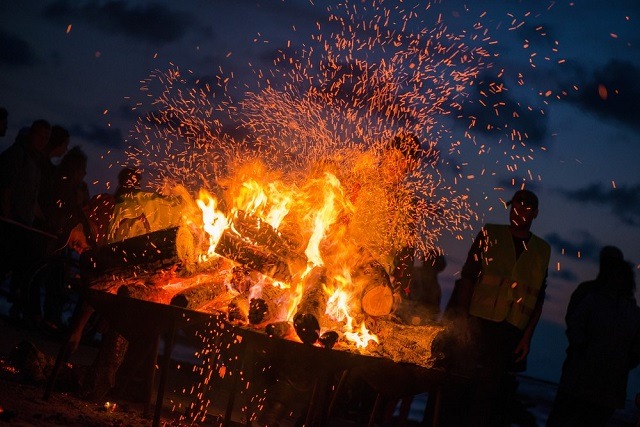Anyone who is in the UK on the 5th November is sure to be aware of a celebration going on all around them. This celebration is known as Bonfire Night. It’s such a widespread celebration that there are many activities, products and events themed around it. There are sometimes special programmes on television and there are even online games centred around it! So, what should we know about this special day?

What Is Bonfire Night All About?
It’s quite tricky to describe what Bonfire Night is all about. Sometimes, it’s known as Guy Fawkes Night. So, who is Guy Fawkes? Why is he being celebrated in November every year? Guy Fawkes is famous for being part of a plot to blow up the Houses of Parliament in London back in 1605. This plot, known as The Gunpowder Plot, was devised as a way of killing the king, James I. People in Britain now celebrate the night on which the plot was foiled by hosting bonfire parties, lighting fires in parks and attending large firework displays.
Why Do We Celebrate Trying To Kill King James?
It may sound silly to celebrate trying to kill a king. After all, the UK is still a country which is ruled by royalty, so the idea of celebrating the attempted murder of a member of the ruling family sounds counterintuitive. Yet, for anyone who understands the Gunpowder Plot and its history, the tradition makes a lot more sense. The very first Bonfire Night, which was held the year after the Guy Fawkes’ plot was foiled in 1606 wasn’t really intended to be a celebration. Instead, it was designed to be a warning to the people of what might happen to them should they too decide to commit treason like Guy Fawkes did.
Guy Fawkes -Who Was He?
Guy Fawkes (or Guido Fawkes) was a soldier who was part of a larger plot to try to blow up the Houses of Parliament. The plot was devised amongst a group of twelve men. All of them were English Catholics. In fact, the leader of the plot was a man known as Sir Robert Catesby, but his name is barely remembered today. Fawkes was put in charge of the gunpowder due to his experience as a soldier. The plot involved renting a room under the Houses of Parliament. The men then filled that room with barrels of gunpowder – 36 of them, to be precise – holding around 2,500 kg of gunpowder. While all the men left, Fawkes remained. It was his job to blow the barrels up before escaping himself. However, a letter had been sent to another Catholic, a man called Lord Monteagle, who was supposed to be going to the Houses of Parliament that day. The letter warned him not to attend, and it was through this letter that the Gunpowder plot was uncovered. Guy Fawkes was caught before he was able to set fire to the gunpowder barrels and was arrested.
The other plot members were also arrested or killed. Those who remained alive were then executed in public as a warning to the country not to commit treason in the same way. The parliament then ordered that there should be a national day dedicated to giving thanks for the king’s safety. This day would be held on the 5th of November every year. On that day, people were obliged to go to church then they held a celebration by lighting a large bonfire. Just half a century later, and that celebration had grown and become more elaborate. By 1650, fireworks had been included in the celebration and even later, a new addition appeared – a man made from old clothes and straw known as the Guy would be put on the fire and burned.
What Was The Gunpowder Plot All About?
The Gunpowder Plot was developed because Guy Fawkes and his friends didn’t like how King James I was treating those of the Catholic faith. Catholics were banned from having churches of their own and so they had to practice their faith in secret. This could be very dangerous since there were serious penalties for those who were caught.
Although the Gunpowder Plot wasn’t the first plan by Catholics to kill the king, it was the biggest plot of its kind. After, lots of people were even more suspicious about Catholics, and this persisted even into the 1700s and 1800s. However, this wasn’t fair, since the majority of Catholics were also upset by the plot and were peaceful.
How Do We Celebrate Bonfire Night Today?
For centuries, Bonfire Night celebrations have been mostly the same. However, unlike in the earliest days, people don’t visit the church as part of their celebration. Most villages, towns and cities have public fireworks displays where people can see a bonfire being lit (often with a guy on top) and watch fireworks being set off. There are usually hot snacks and toffee apples too.
There are even fun games that families can play such as Bonfire Night Bingo. This fun game involves families trying to be the first to dab off every square on their bingo card, each one of which features something which is a classic part of the occasion. From seeing a bonfire being lit or watching a Catherine wheel to wearing a woolly hat or writing their name with sparklers, it’s a fun way to get even more enjoyment from the evening.
Bonfire Night is a fun celebration, even though many people remain unaware of its true origins, and the reasons why we still celebrate this momentous date today.
